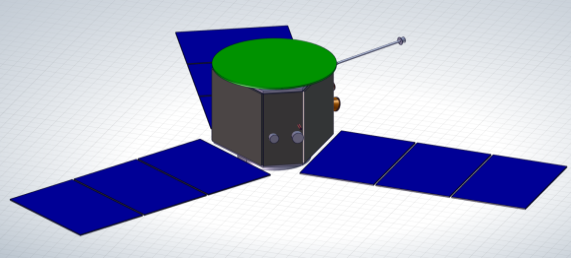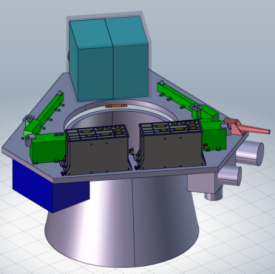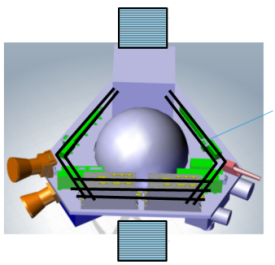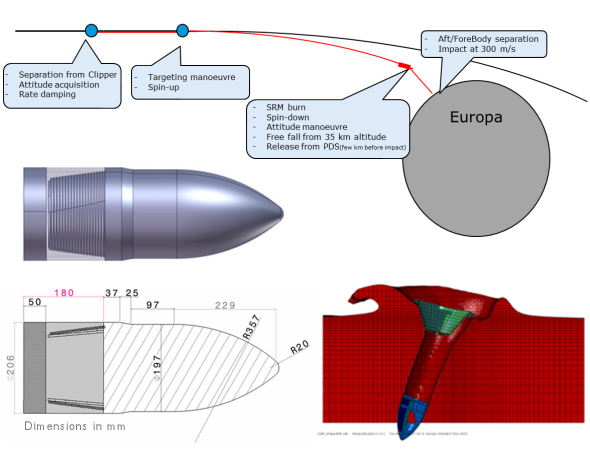Clipper ESA Orbiter (CLEO) and Clipper ESA Penetrator (CLEP)
A brief outline of the CLEO and CLEP concepts is given below. Further details can be found in the CDF study reports for CLEO and CLEP.
Contents of this page
| Mission justification |
| Science objectives |
| Mission requirements |
| Study results - CLEO |
| Study results - CLEP |
MISSION JUSTIFICATION
Following the successful Galileo mission — the only mission to date to have orbited Jupiter — a series of missions towards the Jovian system are currently in development: NASA's JUNO (en route to Jupiter), NASA's Europa Mission (formerly known as Clipper and currently in phase A), and ESA's JUICE (now in phase B, with launch planned for 2022). While JUNO will focus on the Jupiter system, NASA's Europa mission will be dedicated to the eponymous moon, and JUICE will mostly focus on the moon Ganymede. As a potential piggyback contribution to NASA's Europa mission, a flyby mission dedicated to the moon Io or a surface package (penetrator) on Europa would offer a perfect complement to the other Jovian missions.
Following an ESA-NASA bilateral agreement, a mutual interest has been expressed for a contribution of ESA, as a junior partner, to NASA's Europa mission. This contribution, if found to be scientifically meaningful and affordable, could become a proposal to the ESA Cosmic Vision science programme. The ESA contribution could take one of several forms: a 250 kg spacecraft attached to NASA’s orbiter during launch and interplanetary transfer and released after the Jupiter Orbit Insertion (JOI) for close-up investigation of Io or Europa, with in-situ science, either environmental (a small orbiter performing Io (CLEO/I) or Europa (CLEO/E) flybys, possibly through plumes), or close sub-surface science (Europa penetrator (CLEP) and its carrier).
Following a preliminary assessment within the Solar System and Robotic Exploration Missions section of the Future Missions Office, including iterations with the Science Support Team - a small group of experts in the science disciplines covered by the mission, led by the study scientist - three possible mission concepts for an ESA contribution to NASA's Europa mission were considered:
- Concept 1: a minisat concept, with investigations during Io flybys; this is called CLEO/I
- Concept 2: a minisat concept, with investigations during Europa flybys; this is called CLEO/E
- Concept 3: Europa penetrator concept, with high velocity impact on Europa and subsurface investigation (including a habitability package); this is called CLEP
(Note that in this context minisat refers to small satellites in the mass range 100-500 kg.)
Other concepts such as a Europa orbiter and a Europa lander, although scientifically meaningful, were not considered feasible within the allocated mass envelope of 250 kg, and as a consequence were not studied further.
SCIENCE OBJECTIVES
CLipper ESA Orbiter (CLEO)
During the first sessions of the study the baseline mission design for the minisat concept converged towards the Jupiter moon Io. This moon has not yet been explored by close remote exploration nor atmospheric in-situ measurements. The main science case related to Europa (that is not covered by NASA's mission) was the possibility of exploring the plumes of Europa, but this physical phenomenon is still to be confirmed. The baseline minisat concept design is referred to as CLEO-I.
Baseline: Io Flyby Mission (CLEO/I)
To complement NASA's Europa mission and ESA's JUICE science goals, focusing respectively on Europa and Ganymede, CLEO/I would study the moon Io.
Primary science objectives:
- Investigate Io's active volcanism and the nature and magnitude of heat loss
- Investigate the chemistry of Io
- Explore Io as a key element of the Jupiter system
Secondary science objectives:
- Investigate Io’s interior structure
- Investigate Io’s mountains and tectonics
- Investigate Io’s atmosphere and ionosphere
- Investigate Io’s internal magnetic field
- Investigate the tidal heating at Io
Alternative: Europa Flyby Mission (CLEO/E)
To complement NASA's Europa mission and ESA's JUICE science goals, CLEO/E would study the atmosphere/exosphere of Europa and the dust environment, with special emphasis on the plumes.
The key science objectives to be addressed by CLEO/E are:
- Are there plumes on Europa?
- What are the constituents of Europa’s atmosphere/exosphere?
- Are there dust particles present in Europa’s atmosphere/exosphere?
CLipper ESA Penetrator (CLEP)
The focus for a penetrator concept for Europa should be on astrobiology and chemistry, supplemented by key measurements on geophysics. The key science objectives of a Europa penetrator would be:
- Astrobiology of surface and sub-surface
- Chemical composition
- Geophysics: confirm existence of and determine ice depth to moon’s ocean
- Geophysics: characterise surface physical properties, and if possible their variation with depth
- Geophysics: determine additional constraints in interior structure
MISSION REQUIREMENTS
CLipper ESA Orbiter (CLEO)
The main overall drivers for the CLEO design were the mass allocation of 250 kg, the minimum mission lifetime of at least two close flybys with Io, and the science data downlink.
The mass, lifetime and data volume considerations led the study to focus on:
- Trading different mission options with different ΔVs, inclinations and transfer durations
- Looking at lean spacecraft configurations where the redundancy is minimised to reduce mass and power
- Trading different concepts to maximise the science download by changing either direct transmission to Earth or relay to Clipper
- Looking at different operational strategies where the spacecraft would switch between different system modes in order to maximise the data downlink
- Trading different shielding configurations: spot shielding, single vault or series of mini vaults, etc., and,
- Evaluating highly integrated configurations for the spacecraft avionics.
CLipper ESA Penetrator (CLEP)
The mission and systems requirements and design drivers for the CLEP study are provided in more detail in the report (see for example, Chapter 6 in the CLEP CDF report). As part of the outcome of an ESA contract, performed by Airbus Defence and Space in April 2014 under ESA contract #4000105327/NL/HB, the penetrator concept was retained as a starting point for the CDF assessment. It includes two stages for the spacecraft design: the penetrator itself, and a Penetrator Delivery System (PDS) carrying the penetrator and performing the main braking and penetrator targeting after release from the NASA orbiter.
STUDY RESULTS
CLipper ESA Orbiter (CLEO)
The baseline mission design is to separate from Clipper after Jupiter Orbit Insertion, after it performs the perigee reduction manoeuvre. This mission profile has an orbit inclination close to 0 degrees. This has the advantage of allowing a ΔV configuration (low propellant and propulsion system dry mass) but the disadvantage of imposing on the spacecraft higher radiation doses than for an orbit with higher inclination.
The baseline design includes two flybys, the first one with a pericentre at 500 km, and a second one with a pericentre at 100 km. The spacecraft was designed to survive the radiation dose for these two flybys with a design radiation margin of 2. This approach might lead to additional flybys at the end of life.
The study resulted in a CLEO/I spacecraft design with the following characteristics:
| CLIPPER ESA Orbiter to Io | |
  
Credit: ESA
|
|
| Launch Date | May/June 2022 |
| Launcher | Nominal: SLS direct to Jupiter (June 2022) |
| Backup: SLS direct to Jupiter (June 2023) | |
| Alternate: Atlas V 551 EVEEGA (May 2022) | |
| Alternate backup: Atlas V 551 VEEGA (June 2023) | |
| Transfer time | 2.7 years (Nominal), 7.2 years (Alternate) |
| Release from Clipper | After JOI, after PRM |
| From JOI to IGA1 | 1.5 year |
| Nr Flybys | 2 |
| Flyby 1 parameters | Period: 100 days (from Flyby 1 to Flyby 2) |
| Near-equatorial (0.8 deg to Jupiter equator) | |
| Vinf 7 km/s | |
| Perijove: 5.9 Rj (≈ Io orbital radius) | |
| Apojove: 160 Rj | |
| IGA C/A: 500 km Northern Hemisphere | |
| Flyby 2 Parameters | Period: 190 days (from Flyby 2 to next flyby or impact) |
| Near-equatorial (0.2 deg to Jupiter equator) | |
| Vinf 7 km/s | |
| Perijove: 5.8 Rj (≈ Io orbital radius) | |
| Apojove: 260 Rj | |
| IGA C/A: 100 km Southern Hemisphere | |
| ΔV | 345.55 m/s (including margins) |
| Payload | Camera, Mag, MidIR, INMS; 14.82 kg, 51.6 W pPwr |
| Science Duration | 300 mins per flyby (note: Flux gate magnetometer is ON all along the orbit, in low resolution) |
| Data Volume | 7.22 Gb (2.14 Gb + 4.81 Gb) (to be shared between SCI & HK TM) |
| Mass | Dry mass (227.32 kg) (incl DMM) |
| Propellant (39.93 kg) (incl 2% margin) | |
| Wet (266.75 kg) (incl 20% system margin) | |
| Dimensions | Stowed: 1.2×1.2×0.8 triangular shape |
| Structure | CFRP |
| Shielding | Shielding Mass: 19.06 kg (5 mm Al Vaults + 10 mm MINIAvio + 3.5 kg Instruments) |
| Mechanisms | Separation: Clamp band; SA hinges |
| AOGNC | Cruise: Spin; Science: 3-axis stab with RCT. 2 GYROS, 2 STR, 8 SS |
| Propulsion | Monoprop System; 1 tank, 1×22N thruster(6Nom+6R) ×1N RCT |
| Power | 6 m² SA; MPPT; 4.9 kg Battery (690 Wh); Unregulated Bus |
| Communication | X-Band HGA 1.1 m (tx) – 0.6 m (Rx); 2 LGA, RF pwr 65W; TM rate 3.5kbps; TC rate 1kbps (35 m GS) |
| DHS | MINIAvio (OBC + PCDU + STR processing + Gyros + Instrument processing) |
| Thermal | Ext. MLI, Int. MLI, Instruments MLI, prop. MLI; 0.15 m² 2×Louvers; 6m heat-pipes; heaters; sensors. Propulsion heating power 25 W; platform Heating Power JC 5 W |
The baseline configuration does not meet the 250 kg mass allocation (266.75 kg). In addition to the baseline configuration, two more options were evaluated at system level:
- A hyperbolic flyby option with much reduced ΔV requirements (CLEO/I hyper), and,
- An option with Europa flybys instead of Io (CLEO/E).
In the hyperbolic flyby option, the spacecraft would not perform flybys around Jupiter but would remain in a hyperbolic trajectory (only one flyby is possible). It would separate from Clipper before Jupiter Orbit Insertion and only perform targeting manoeuvres estimated at around 40 m/s, which would lead to a much lower propulsion system (lower propellant mass and dry mass) and lower shielding mass due to the lower mission duration.
In the Europa option (CLEO/E), the spacecraft would target Europa instead of Io. Both these options would allow meeting the 250 kg mass allocation. Full details can be found in the CDF study report.
STUDY RESULTS
CLipper ESA Penetrator (CLEP)
The CLEP baseline mission design is to separate from Clipper from a 3:2 Europa resonant orbit, hence requiring a significant modification of the nominal Clipper tour. In particular, four dedicated Europa flybys by Clipper are required in this modified orbit to release the CLEP spacecraft and ensure data retrieval after impact. While first and last flybys are mainly driven by the celestial mechanics (to come from and go back to the Clipper nominal tour), the second and third flybys would need to be optimized for CLEP requirements (to allow impacting the selected 'landing' site, and to allow for sufficient visibility from Clipper at impact and during subsequent flyby for data retrieval). CLEP is released by Clipper 1.75 days before the second flyby. CLEP performs a Europa targeting manoeuvre six hours after release. This manoeuvre is followed by a main braking manoeuvre, and a final free-fall phase, which allow to meet the required impact speed of 300 m/s with acceptable dispersions. This strategy allows to limit the landing error to a 300 km radius ellipse, offering a few minutes visibility of the penetrator by Clipper at impact during its second flyby, and permitting data transfer to Clipper during 46 minutes at the third flyby, occurring 10.5 days later.
The CLEP baseline spacecraft design includes two stages: the penetrator, and a Penetrator Delivery System (PDS) carrying the penetrator and performing the main braking and penetrator targeting after release from Clipper. The PDS relies on a Solid Rocket Motor (STAR24) to perform the braking manoeuver. The CLEP penetrator itself is composed of a forebody (penetrating the surface and including a highly miniaturized science payload of less than 3 kg – this design is based on an Airbus design performed in the frame of an ESA contract) and an afterbody (remaining on the surface at impact and including a flat textile antenna for data relay to Clipper). The forebody and afterbody are linked via a flexible umbilical of 10 m (for power and communication), and separated before the impact. This strategy was found to be the best to allow for communications with Clipper, whatever the texture of the soil and the surface topography.
The study resulted in a CLEP spacecraft design with the following characteristics:
| CLIPPER ESA Penetrator to Europa (CLEP) | ||

Credit: ESA
|
||
| Launch date | May/June 2022 | |
| Launcher |
SLS direct to Jupiter in June 2022 is nominal plan; SLS direct to Jupiter in June 2023 is backup plan. Atlas V 551 Earth-Venus-Earth-Earth Gravity Assist (EVEEGA) launching in May 2022 is alternate plan with Atlas V VEEGA launching in June 2023 as alternate backup. |
|
| Transfer Time | 2.7 years | |
| CLIPPER Tour Modification |
~ 14 months after JOI and after 7 high v-infinity nominal Europa fly-bys 24 additional perijove passages at Europa radius V infinity at release of the PDS: 1.68 km/s Additional mission duration: 150+45+150 = 345 days |
|
| CLIPPER additional Fly-by Sequence characteristics | EGA 1 altitude | 2870 km, crank-up |
| Orbit | 3:2 | |
| EGA 2 altitude | 90 km, crank-up | |
| Orbit | 3:2 | |
| EGA 3 altitude | 2550 km | |
| Orbit | 3:4 | |
| EGA 4 altitude | 456 km | |
| Orbit | 1 revolution transfer to Ganymede | |
| Time from EGA 1 to Ganymede | 44 days | |
| Payload | E-PAC, Seismometer; 2.7 kg, 50 Wh energy over 10.5 days | |
| Landing Site | A3. See section 5.3.2 in the report. | |
| Ellipse landing dimensions | ~ 300 × 300km | |
| PDS Release from CLIPPER | 1.75 days before 2nd Europa fly-by, followed by a targeting manoeuvre at -1.5 days and Europa impact | |
| CLIPPER visibility from the penetrator |
At impact for few minutes (2 min at 30 deg elevation) Post- impact, only after 10.5 days for data relay, and for 46 minutes |
|
| PDS Targeting ΔV | 10 m/s | |
| PDS Burn ΔV | 2660 m/s | |
| Free-Fall height PDS+Penetrator | 35 km | |
| Impact Velocity Penetrator | 300 m/s | |
| Penetrator Design Concept |
ForeBody + AftBody Umbilical Cable assumed 10 m (TBC by test, Penetrator Equations from Sandia National Laboratories) |
|
| ForeBody | Assumed as per AIRBUS Design | |
| AftBody | Textile antenna (40cm×40cm mounted on 4×1m tape springs), umbilical cord with comms and power lines | |
| Mass |
Dry: 109.71kg incl 20% system margin Wet: 308.79kg incl 20% system margin Liquid Propellant Mass (Targeting + AOCS): SRM Propellant Mass (STAR 24): |
|
| Radiation Shielding Mass |
12.68 kg (spot shielding of sensitive equipment) required for Transfer phase. Radiation through the ice is negligible and no shielding is required. No radiation sensitive equipment will stay on Europa surface. |
|
| Propulsion |
Liquid (targeting, rate-dumping, spin-up, spin-down) - 1 × PEPT 230 tank, central axis - 3 × 20 N thrusters (main deltaV) - 2 × 20N + 2 × 20 N thrusters for spin/de-spin Solid (de-orbiting) - STAR 24: - 199.9 kg Solid propellant - 18.2 kg case - Isp: 282.9 s |
|
| Penetrator Power |
Energy req: 609 Wh incl 20% margin Primary Battery: Li-CFx 2.55 V per cell – 3s 6p 1377 Wh nameplate energy |
|
| PDS Power |
Energy req: 1980 Wh incl 20% margin Primary Battery: Li-CFx 2.55 V per cell – 5s 9p 3442 Wh nameplate energy PCDU |
|
| Communications |
1 Receiver; 1 Transmitter; 1 Diplexer (PDS) Deployable textile Antenna (penetrator) Fixed LGA in Penetrator ForeBody (penetrator) Umbilical RF Cable connecting Fore-body to antenna (penetrator) |
|
| Link Budget |
Tx power: 1 W (penetrator) DataRate: 3 kbps (penetrator) Elevation > 30 deg (penetrator) Margin > 3 dB (penetrator) Achievable Data volume: 8 Mbit (penetrator) |
|
| AOCS/GNC |
Micro STR (PDS) GYR on a chip (PDS) Capacitive MEMS ACC (PDS) [Optional] Altimeter on PDS for Penetrator/PDS Separation |
|
| Penetrator Thermal |
2 "enclosures" architecture Energy Requirement considered: 20 Wh/day |
|
| PDS Thermal |
MLI Kapton Foil Heaters Heating Power Consumption: 25 W |
|
| Penetrator Structures | Assumed same as AIRBUS industrial design | |
| PDS + Penetrator Mechanisms |
Clipper/CLEP Separation Mechanism: AIRBUS concept. PDS/Penetrator Separation Mechanism: AIRBUS concept. AftBody/ForeBody Separation Mechanism: pyro-mechanism triggering parachutes-like lines deployment. Textile Antenna Deployment Mechanism (passive): 4 × 1 m tape springs, with antenna 40 cm centred at intersection point. Cylinder with lid to be ejected by parachute deployment system. |
|
Full details can be found in the CLEP CDF study report.
